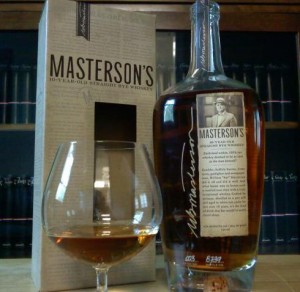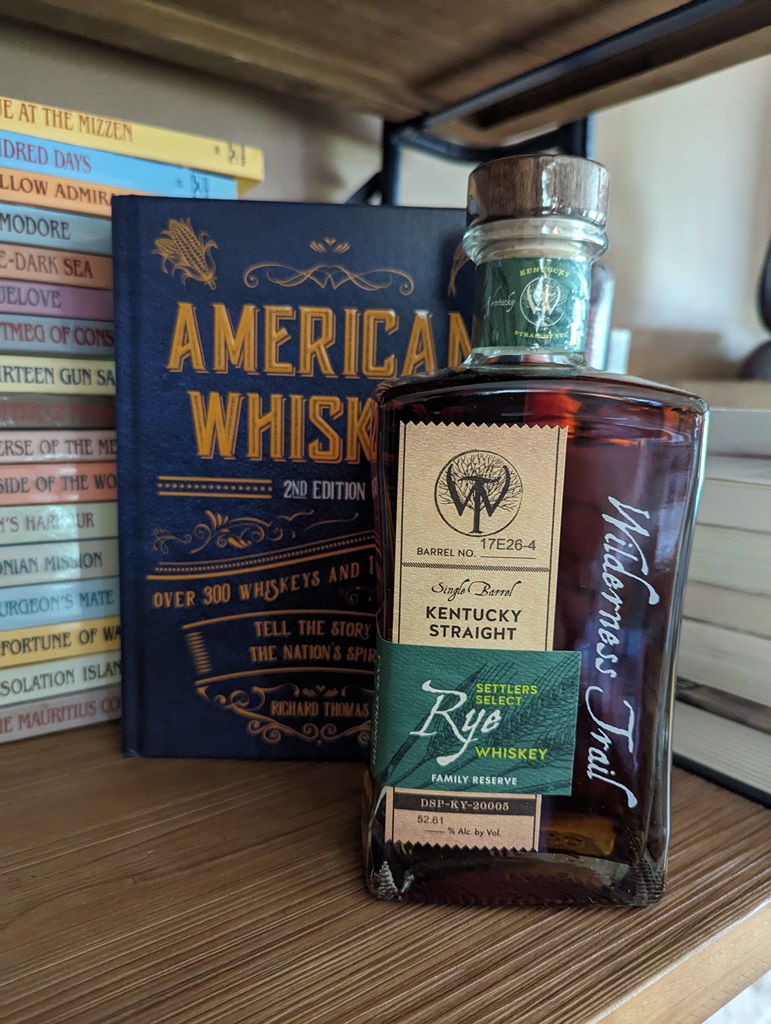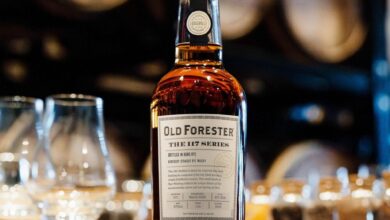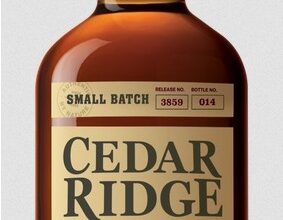Rye Whiskey’s 21st Century Comeback
By S.D. Peters
Virginia, August 2015

(Credit: S.D. Peters)
I was at my local Virginia ABC Store to purchase a bottle of Wild Turkey Rye. The manager, who was working the counter, asked if I’m particular to Wild Turkey.
“The 101’s my go-to bourbon,” I said; then, nodding at the bottle of WT Rye on the counter, “but that’s what I always keep on hand. Although I wish they hadn’t discontinued its 101 expression.”
As it turned out, the exchange was a lead-in to see if I might have been interested in the bottle of Wild Turkey’s 17 year-old Masters Keep the manager has in stock. I was, but mention of Wild Turkey 101 Rye piqued the manager’s interest and changed the subject.
“101? Really? Where did you get it?”
“Pennsylvania, Jersey or New York. I could never find it in Virginia.”
Virginia’s ABC stores, in fact, hadn’t carried it in recent memory, the manager confirmed. At least not in Northern Virginia. Probably would now, though, had it not been discontinued.
I recalled that it wasn’t long ago—early years of the turn of the century—the only Rye on most shelves, anywhere you went, was Old Overholt or (the old version of) Jim Beam. Wild Turkey was there only if you were lucky. Rittenhouse or old Pikesville on rare occasions. This recollection is a habit of mine, and I’ll work it into any conversation on the subject Rye, especially with other long-time Rye drinkers.
The manager agreed, and we talk briefly about the variety of Rye that’s now available. Lately there seems to be new brands on the shelves every few months, and I suspect the stocks of the other now-established ones must be pretty good now, too, because the manager added: “Well, Rye sales have been better than ever.”
The State of The Rye, 2015
A spontaneous, short, and routine conversation between a Rye drinker and a liquor sales manager (or bartender, whiskey writer or anyone else with more than a passing interest in whiskey) isn’t much of an informative experience, or the contents all that surprising. You would need to know nothing at all about Rye whiskey to be surprised that the drink had ever been anything but a common commodity.
Look no further than the latest report from the Distilled Spirits Council of the U.S. “Since 2009, Rye whiskey volumes have grown 536% from 88,000 9-liter cases to over a half million cases… in 2014.”
Around the midway point of that growth, in 2012, a Whiskey Reviewer feature noted that DISCUS’ reported a 50% increase in Rye sales in 2011, a demand that boosted Rye production by big distillers and convinced the growing number of small, independent distillers to add Rye to their product line, or even to make Rye their entry product.
At the same time, we reported the occasional disappearance of a standard like Old Overholt from store shelves, and quoted the owners of brands like Masterson’s 10-Year Old and McKenzie’s, who were worried their products might soon be in short supply.
Since then, there hasn’t been any clear indication that any particular brand or expression of Rye is going the way of, say, a bottle of Pappy Van Winkle, or worse, Japanese whisky. If you have a collection of very rare, vintage Rye (like, say, Rittenhouse 25 Year Old Single Barrel, the most expensive Rye around) stored in the basement of a house rented to an unreliable and very thirsty tenant, then you may have problem; otherwise the demand for and sale of Rye appear to be in step.
Perhaps it’s an over-simplification. From this writer’s experience, I’ve typically seen no less than 10 varieties of Rye, and not always the same assembly of brands, for sale in Virginia, including in more isolated regions like the Northern Neck, as well as Maryland, D.C., Pennsylvania, New Jersey, New York and Vermont. That range is contained to the Northeast, true, but it’s also densely populated, thirsty area. My perception is backed up by the latest DISCUS report, which adds that “[b]y 2014, there were over 100 brands,” so even if there is a shortage of any one particular brand and a particular time, there are plenty more to step into its place.
A Rye Digression
In 2012, when we first reported on the Rye craze, we noted that “for the most part [the Rye craze] is not driven by a rapid expansion in the ranks of Rye lovers” but rather “for [Rye’s] prominent place in the ongoing… boom in upscale cocktails.” At the time, Rye drinkers who preferred sipping the straight stuff were also the sort who’d been drinking Old Overholt, Jim Beam, Wild Turkey, Rittenhouse, or, if they found it, Pikesville, for years (possibly decades), at a time when other whiskey lovers were enamored with Scotch or Bourbon and looked askance at Rye.

(Credit: S.D. Peters)
Devoted Rye drinkers often have a rarefied and opinionated taste for the mild sweet/strong spice dichotomy of the distilled grain, and an inherent attraction to outsider status in the whiskey world. Consider that the highly popular Bourbon, Makers Mark, forsakes Rye for wheat in its mashbill in large part because its original owner, Bill Samuels, Sr., vehemently disliked what the Rye grain does in spirits, and you can get an idea of why Rye drinkers are the sort who take some pride in their choice of drink.
Whither Rye?
Three years later, the revival of cocktail culture continues to feed the demand for and sales of Rye, but only in part. To be sure, the latest DISCUS report cited that revival as a factorm but it is now the third of three general factors contributing to the overall revival of Rye whiskey. Possibly overtaking cocktail culture is a growing interest in American whiskey and its heritage can’t ignore the influence of the grain at the heart of that heritage.
The DISCUS report suggests as much in referencing the reconstruction of George Washington’s historic distillery at Mount Vernon, which since 2007 produces unaged and aged versions of the only whiskey Washington produced: Rye. Given the historical-cum-mythical reverence for Founding Father George in America, it’s bound to have an influence on some folks’ choice of drink.
Interest in whiskey heritage may naturally lead to an increased number of drinkers who want sip their Rye straight. Or it may not. The tumbler is half-empty or half full depending on how you look at it, but if the number of devoted Rye drinkers isn’t swelling, plenty of others are adding it as a second or third choice.
What seems obvious is that whether Rye whiskey is consumed neat, on the rocks or in a cocktail (and I support the revival of Rye as a cocktail base; if one’s gonna drink ‘em, why not mix ‘em with the best?), that consumption ought to keep the boom going for a while. According to the DISCUS report, Rye “still represents a small share of the overall American whiskey category.” Some cite that as proof of Rye’s unimportance, but to me that means the category still has plenty of room for to grow.
Washington, D.C., December 2013
I was tasting the 2013 edition of George T. Stagg Bourbon at Jack Rose’s Saloon on 18th St, just above U Street. There were strong hints—no, not hints; notable characteristics—of Rye in this edition. Imagine a sea swimming with peppercorns and aromatic of nutmeg, sails filled by a clove-scented breeze, and a leisurely cruise toward a distant horizon of cardamom and coriander. If this is Bourbon, it barely qualifies. And that’s just fine.
As I was noting all this, between pauses to relish the aroma some more and pangs of regret that at some point, the glass emptied and the bartender said:
“Good stuff, huh? The 2013 introduced a lot more Rye into the mashbill.”
Having also just tried the 2011 and 2012 Staggs, I agreed. There was more Rye in all of them than in most Bourbons. Or at least all the senses strongly suggest there was. But in the 2013, the strongest suggestion was that it had transcended Bourbon, and for a Rye drinker, that can only mean it’s become Rye, with the inherent sweetness of corn lingering floating about like seraphim.
I tapped my notebook. “Exactly what I just noted,” I said.
“It’s really making a comeback,” said the bartender. “Rye, I mean. I couldn’t be happier about it.”
As I take the last sip of the 2013 Stagg and savor it, I’m thinking, if it’s gotten to this point, where a Bourbon can pass for a Rye and a bartender takes the time to comment that’s a good thing, then I couldn’t be happier, either.




